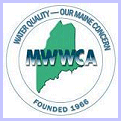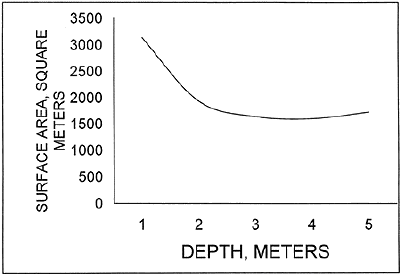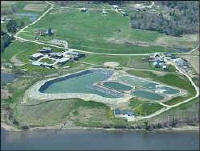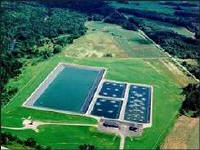|












2003
Maine Wastewater Salary Survey as conducted by the Maine Wastewater Control
Association

2003 Maine
Wastewater Rate Survey conducted by the Maine Rural
Water Association

Maine DEP Monthly
O & M Newsletter
Maine and WEF's
Operation Forum
Penobscot Watershed and Development of a TMDL
EPA Binational Toxics
Strategy
Maine Rural Water
Association
Maine Wastewater
Operator Certification
Guide
Maine Is Technology
Newsletter
Maine
Wastewater Control Association

Maine
Wastewater Engineering
Firms
| |
AERATED
LAGOON TECHNOLOGY

by
Linvil G. Rich
Alumni Professor Emeritus
Department of Environmental
Engineering and Science
Clemson University -
Clemson, SC 29634-0919 USA
Email: lrich@clemson.edu;
Tel. (864) 656-5575; Fax (864) 656-0672
Technical Note Number 3
CONTROL OF
ALGAE
The
problem with algae was discussed in Technical Note 2. Algae growing in an
aerated lagoon system will increase both the TSS and the CBOD5 of the effluent.
In systems treating municipal wastewaters, the effluent TSS and CBOD5 will often
be many times that which would occur if the algae had not been present. Effluent
values of these parameters inflated by algae offer no clew as to how well the
lagoon is removing the influent TSS and CBOD5. Consequently, engineers
mistakenly assume that because the effluent TSS and CBOD5 are approaching, or
exceeding, the limit, additional treatment capacity is required when in fact the
current capacity may be (and probably is) excessive. Since algae are a distinct
liability and play no beneficial role in aerated lagoons, a consideration of
ways to prevent, or control, algal growth should be of interest to those
responsible for the design and operation of these systems. Such consideration is
the focus of this technical note.
Hydraulic Retention Time (HRT)
Retention time is the most influential factor controlling algal growth. In a
lagoon basin with a depth of at least 3 m and fitted with mechanical surface
aerators that provide a power intensity of about 1.6 W/m3 (8 hp/106 gal of basin
volume) or less, algal growth can be expected to occur if the HRT exceeds about
2 d (Fleckseder and Malina 1970; Toms et al. 1975). If, however, the lagoon
basin is divided into two or three cells in series by curtain walls, algal
growth can be expected to occur only if the total HRT exceeds about 3 d, and 3.6
d. respectively (Rich 1999). Thus, the post fitting of a lagoon basin with
curtain walls may reduce effluent algae. At greater aeration power intensities,
shading provided by the suspension of settable solids reduce algal growth. At an
intensity of 6 W/m3 (30 hp/106 gal), very few algae will grow.
Depth
As photosynthetic organisms, algae require light to grow. Per unit volume
of lagoon basin, the quantity of light energy available for such growth is
proportional to the surface area. For a basin with vertical sides, an increase
in the depth will decrease the surface area proportionally. However, because of
the trapezoidal cross section typical of lagoon basins, an increase in depth
does not always decrease the surface area. Figure 1 illustrates the relationship
between the two variables for a basin with a volume of 2840 m3 (750,000 gal) and
with side slopes of 1 (vertical) 3 (horizontal). For such a basin, an increase
in depth will decrease the surface area up to a depth of about 3 or 4m. Beyond
which depths the surface area begins to increase.

Figure 1.
Figure 1. Surface area vs. depth for a lagoon basin with a volume of 2840 m3 and
side slopes of 1(vertical):3(horizontal)
Lagoon depths of 3
or 4 m will also create a more favorable geometry for mixing with surface
aerators. Reduced surface areas will position the mixing zones in closer
proximity.
Mixing
As was discussed above, if a lagoon basin treating a domestic wastewater is
fitted with mechanical surface aerators that provide a power intensity of at
least 6 W/m3 of basin volume (30 hp/106 gal), the turbidity of suspended solids
is sufficient to minimize algal growth. At lower mixing intensities, algae will
grow providing the HRT is sufficient. However, all lagoon basins, including
those that are used for sedimentation (polishing), should be mixed a level of
about 1 W/m3 of basin volume (5 hp/106 gal). Such mixing is beneficial from
several points of view. Without mixing thermo stratification will occur, thereby
permitting the retention of undisturbed surface layers for relatively long
periods of time. Such conditions provide an excellent environment for algae to
become established and grow.
Mixing will also exhaust the carbon dioxide from the system. For
wastewaters, such as those from domestic origin in which there is an excess of
nitrogen and phosphorus, carbon dioxide can be growth limiting during a portion
of the diurnal cycle. During the night hours when light is not available, carbon
dioxide accumulates as the result of respiration of the microorganisms in the
lagoon. At dawn, when light does become available, the rate of consumption of
carbon dioxide through photosynthesis exceeds that of respiration and, as a
result, the store of carbon dioxide is depleted and algal growth becomes
limited. In other words, the carbon dioxide accumulated during the night hours
is stored for use in the daytime hours. Carbon dioxide concentrations as high as
25 mg/L have been observed at night in lagoons (Williford and Middlebrooks
1967). Since at sea level the saturation concentration of carbon dioxide is only
about 0.42 mg/L at 20° C, mixing by aeration will remove significant quantities
of carbon dioxide from the system during the night hours, thus ensuring that
carbon dioxide becomes growth limiting earlier in the day. During the day, when
carbon dioxide is growth limiting, aeration does not significantly replace
carbon dioxide in the system because the concentration gradient is too low. As
will be discussed in later notes, aeration in settling basin is a must, not only
because of the mixing that is created, but also, for the maintenance of
dissolved oxygen in the water column. Such maintenance reduces feed back of CBOD
and nitrogen from the benthal deposits.
Cover
Cover of any type, artificial or natural, that will prevent light from
entering the water column of a lagoon will prevent the growth of algae.
Commercially available floating polyester fabrics have been used to shade
aerated lagoons. Such shades should not cover the entire lagoon surface, leaving
sufficient room for mechanical surface aerators.
Natural cover can be provided by surface-growing plants such as duckweed.
Duckweed, if kept from the effluent by inserting surface baffles in front of the
effluent weir, is very effective toward reducing algae in the lagoon.
Furthermore, experience in South Carolina has shown that for aerated lagoons, it
is not necessary to periodically harvest the duckweed, nor does the duckweed
appear to result in significant accumulations in the bottom of the lagoon.
Floating grids placed across the lagoon surface have been used to ensure surface
coverage. However, several aerated lagoons covered with duckweed have operated
successfully without grids. Regardless of the type of cover used, provision must
be made for aerating the lagoon. Otherwise, the lagoon will become anaerobic.
Intermittent Discharge
Algae respond to the diurnal variation in light by moving vertically
through the water column. King et al. (1970) found that during the afternoon
hours, the particulate COD at 8 inches below the surface of a facultative lagoon
was about four times that at the same depth during the night hours. Such
vertical migration suggests that effluent quality might be improved if the daily
flow is released only during the night, or from two different depths over the
diurnal cycle.
Chlorination
Several studies have shown that chlorination will kill algae. The focus of
most of these studies has been on the impact that algae have on the chlorine
demand of plant effluents. In these studies, the chlorine doses used have been
large (5-20 mg/L) and the contact periods short (15 min to 2h), conditions under
which algae are killed and lyse. At least two authoritative studies, however,
have shown that much lower chlorine doses (2-4 mg/L) over much longer contact
periods (>10h) will impair algal growth (Echelberger et al. 1971; Kott 1971).
This suggests that by continually adding chlorine in a relatively low dose in a
aerated lagoon settling basin, effluent algae reduction would occur as a result
of a lower growth rate.
Copper Sulfate
Copper sulfate has long been used by waterworks personnel to control algal
growth in reservoirs. Some waterworks personnel use a standard dose of 1 mg/L of
copper sulfate which is sufficient to kill most types of algae. However, care
must be taken to protect fish in the receiving stream. Trout, which appear to be
the most sensitive of the fish, do not tolerate copper sulfate in concentrations
greater than about 0.14 mg/L (Steel and McGhee 1979). It has been reported that
the combination of chlorination and copper sulfate has given excellent results (Courchene
et al. 1975).
Water Soluble Dyes
Certain non-toxic, organic water soluble dyes that blocks out the specific
light rays utilized in photosynthesis are used for killing algae. Some of these
dyes, which leave the water a natural teal blue, have been used to kill algae in
sewage lagoons. Such dyes are marketed commercially.
Effluent Treatment
During the late 1960's and early 1970's, much research was conducted on the
removal of algae in the effluents of lagoon. At least three review papers
describes the scope of such research (Kothandaraman and Evans 1972; Middlebrooks
et al. 1974; Parker 1975). A wide range of wastewater treatment processes were
investigated in the hope that effluent treatment would be economically feasible.
With a single exception, it appears that none of the processes are at the
present considered to be feasible, especially for the treatment of aerated
lagoon effluents. The exception is intermittent sand filtration, which is used
primarily to achieve nitrification, the removal of algae being an added benefit.
The performance of intermittent sand filtration in the treatment of aerated
lagoon effluents will be discussed in a future technical note. Rapid sand
filtration has two disadvantages. The removal of some algal species is marginal,
and there is always the problem of what to do with the back-wash water. If the
back-wash is simply recycled to the lagoon, algae accumulates in the lagoon,
causing more frequent back wash.
REFERENCES
Courchene, J. E. and
Chapman, J. D. (1975). "Algae control in Northwest Reservoirs". J. AWWA, 67(3),
127.
Echelberger, W. F. et
al. (1971). "Disinfection of algal laden waters." J. San. Engr. Div., ASCE,
97(5), 721-730.
Fleckseder, H. R. and
Malina, J. F. (1970). "Performance of the aerated lagoon process." Technical
Report CRWR-71, Center for Research in Water Resources, University of Texas,
Austin, TX.
King, D. L. et al.
(1970). "Effect of lagoon effluents on a receiving stream." 2nd Symposium for
Water Treatment Lagoons, Kansas City, MO, June 23-25.
Kothandaraman, V. and
Evans, R. L. (1972). Removal of Algae from Waste Stabilization Pond Effluents -
A State of the Art. Circular 108, Illinois State Water Survey, Urbana, IL.
Kott, Y. (1971).
"Chlorination dynamics in wastewater effluents." J. San. Engr. Div., ASCE,
97(5), 647-659.
Middlebrooks, E. J.
et al. (1974). Evaluation of Techniques for Algae Removal from Wastewater
Stabilization Ponds. PRJEW115-1, Utah Water Research Lab., Utah State Univ.,
Logan, Utah.
Parker, D. S. (1975).
Performance of Alternative Algae Removal Systems. Seminar on Ponds as a
Wastewater Treatment Alternative, Univ. of Texas, Austin, TX, July22-24, 1975.
Rich, L. G. (1999).
High Performance Aerated Lagoon Systems. American Academy of Environmental
Engineers, Annapolis, MD.
Steel, E. W. and
McGhee, T. J. (1979). Water Supply and Sewage, McGraw-Hill, New York, NY.
Toms, I. P. et al.
(1975). "Observations on the performance of polishing lagoons at a large
regional works." Water Pollution Control, 74, 383-401.
Williford, H. K. and
Middlebrooks, E. J. (1967). "Performance of field-scale facultative wastewater
treatment lagoons." J. WPCF, 39, 2008-2019.

|

